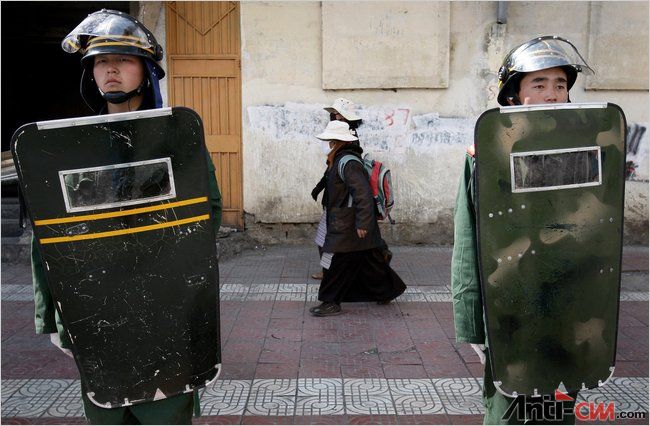|
|
A Trip to Tibet, With My Handlers NearbyBy EDWARD WONGPublished: July 31, 2010
http://www.nytimes.com/2010/08/01/weekinreview/01wong.html?scp=7&sq=China&st=cse
LHASA, Tibet — One warm morning on the campus of Tibet University, a couple of foreign journalists on a government-run tour of Tibet quietly broke away from the group to talk to students standing on a grassy lawn. Security guards dashed in and waved the students away.

WATCHING In Tibet, the government keeps the people and the press under guard. Harmony is the official catchword these days.
Two days later, Chinese officials brought the 30 or so foreign reporters to the sprawling Tashilhunpo Monastery in Shigatse, the seat of power of the Panchen Lama, a reincarnated leader in Tibetan Buddhism. The officials had arranged for a monk to brief us on the monastery’s history. But reporters preferred to pepper him with questions about the selection of the 11th Panchen Lama — the Chinese government appointed one in 1995 after whisking off a 6-year-old boy endorsed as the genuine reincarnation by the exiled Dalai Lama. The boy and his family have not been seen since.
A foreign ministry official from Beijing quickly signaled an end to the talk. Later, walking through the white-walled monastery, the official shook his head and said to me: “The questions you all ask — what’s the word I’m looking for? — they’re ridiculous!”
These days, the Chinese government wants foreigners to think it is moving beyond Orwellian controls on information. In Beijing and most other parts of China, a foreign journalist can usually travel freely. Plainclothes officers don’t regularly follow journalists around. And ordinary people who talk to journalists usually do not fear reprisals from the authorities, unlike many Tibetans, who speak to foreign reporters only in quick, furtive conversations because of the omnipresent security forces.
China is pushing its state news agency, Xinhua, into new markets in hopes that foreign publications will run its stories as if they are those of The Associated Press or Reuters. Xinhua is even opening a newsroom in Times Square. One Xinhua reporter asked me, “When will foreigners view us like The A.P.?”
The Chinese government and its information agencies crave legitimacy among foreigners, and a growing number of Chinese journalists are trying to push the boundaries. But open and critical inquiry is still an alien concept to Chinese officials, as I discovered on this five-day government-run tour of Central Tibet.
In general, Chinese journalists still have to tip-toe around strict censorship measures. We foreigners know that we are being monitored, however subtly. And when it comes to certain important issues — like sovereignty and treatment of minorities — China places tight restrictions on domestic and foreign reporting.
That means that reporting on Tibet, Taiwan and Xinjiang, where ethnic tensions run high between Uighurs and Han, is still fraught.
Foreign journalists are forbidden from travelling independently to the Tibet Autonomous Region. A government-sponsored tour, held about once a year, is the only way in. And woe to reporters who cross some invisible line. Two Polish journalists recently discovered that they are on a blacklist for Chinese visas, one possibly because of his Tibet reporting.
Harmony, however, is the official catchword these days — including between the government and Tibetans, and the government and journalists. So two years after the largest Tibetan uprising in decades and the continued arrests of Tibetans accused of subverting state power, reporters on this trip received a heavy dose of ethnic entertainment, beautiful scenery and stage-managed interviews.
An hour after we checked into our hotel in Lhasa, as the afternoon sun dipped toward stark brown peaks, we were bussed to the Nangre Folk Customs Park for a buffet dinner that included several song-and-dance routines.
The next day, two tour buses and a police escort shuttled us around. At a village called Gaba, we talked to residents about new homes they had built with subsidies and loans under a government mandate called the “comfortable housing” program, begun in 2006. Gaba was a model village, and clearly not representative. In fact, the visit to Gaba was reminiscent of ones during the Cultural Revolution, when officials brought foreigners to similar model villages to demonstrate the country’s progress.
(The living room décor did not help: In each home, there was the same poster featuring the smiling countenances of Mao, Deng Xiaoping and Jiang Zemin, the three paramount leaders of China.)
There were occasional reminders of reality. One morning, our minders wrung their hands when cameramen on my bus filmed more than 150 military trucks with ethnic Han soldiers rumbling along a highway to Lhasa.
The last day, as we boarded the buses for a four-hour ride to the airport, reporters griped to one another about the tight leashes, but agreed that going on the trip was better than having no access at all. Just riding through the sweep of the Himalayas made up for all the frustrations. We stopped for lunch by a stunning holy lake, Yamdrok Tso, nestled high in the mountains.
Then, as we packed up to go, an Australian and a British reporter each stripped naked and dove into the waters.
I looked over at our minders. The ones from Lhasa were laughing, and so were our police escorts, from behind their mirrored sunglasses. It had been a long five days.
A version of this article appeared in print on August 1, 2010, on page WK4 of the New York edition. |
Handlers, nearby, NYT, Tibet, trip, Handlers, nearby, NYT, Tibet, trip, Handlers, nearby, NYT, Tibet, trip
评分
-
1
查看全部评分
-
|